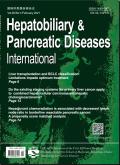自身免疫性胰腺炎患者骨骼肌损失和肌肉减少的患病率及危险因素
IF 4.4
3区 医学
Q2 GASTROENTEROLOGY & HEPATOLOGY
Hepatobiliary & Pancreatic Diseases International
Pub Date : 2025-05-23
DOI:10.1016/j.hbpd.2025.05.002
引用次数: 0
摘要
背景:以往的研究强调,肌肉减少症在包括慢性胰腺炎在内的胰腺疾病患者中经常发生。我们旨在阐明自身免疫性胰腺炎(AIP)患者骨骼肌(SM)损失和肌肉减少的患病率,以及它们与临床特征、骨矿物质密度和胰腺影像学表现的关系。方法:选取东北大学附属医院收治的114例AIP患者为研究对象。使用生物电阻抗分析装置评估SM指数,使用手部测力仪测量握力,使用双能x线吸收仪评估骨密度。采用单因素和多因素logistic回归分析分析与SM丧失和肌肉减少症相关的因素。结果:114例患者中,57例(50.0%)有握力丧失,31例(27.2%)有握力下降,27例(23.7%)两者兼有。与没有SM丧失的患者相比,SM丧失的患者年龄较大,体重指数较低,握力较弱,控制营养状态评分较高,血清脂肪酶和白蛋白水平较低。计算机断层扫描显示,SM丧失患者胰腺实质萎缩的发生率较高。在肌肉减少症患者和非肌肉减少症患者之间观察到类似的差异。35.6%的SM丢失患者和38.1%的肌肉减少患者出现了骨病,而没有SM丢失的患者中只有4.1%出现了骨病。在多因素分析中,低BMI (< 21.0 kg/m2)也被发现是SM丧失的独立危险因素。多因素分析显示,年龄bb0 ~ 72岁、低BMI (< 20.0 kg/m2)、低血清脂肪酶水平(< 13 U/L)是肌少症的独立危险因素。结论:SM丢失和肌肉减少在AIP患者中普遍存在,并与衰老、营养状况不佳、血清脂肪酶水平低和胰腺实质萎缩有关。除了患骨病的高风险外,还应注意保持AIP患者的肌肉健康。本文章由计算机程序翻译,如有差异,请以英文原文为准。
Prevalence and risk factors of skeletal muscle loss and sarcopenia in patients with autoimmune pancreatitis
Background
Previous studies have highlighted the frequent occurrence of sarcopenia in patients with pancreatic diseases, including chronic pancreatitis. We aimed to clarify the prevalence of skeletal muscle (SM) loss and sarcopenia, and their associations with clinical characteristics, bone mineral density, and pancreatic imaging findings in patients with autoimmune pancreatitis (AIP).
Methods
This study included 114 patients with AIP treated at Tohoku University Hospital. The SM index was assessed using a bioelectrical impedance analysis device, grip strength was measured using a hand dynamometer, and bone mineral density was evaluated using dual-energy X-ray absorptiometry. Univariate and multivariate logistic regression analyses were used to analyze factors associated with SM loss and sarcopenia.
Results
Among 114 patients, 57 (50.0%) had SM loss, 31 (27.2%) had reduced grip strength, and 27 (23.7%) had both. Patients with SM loss were older and had a lower body mass index, weaker grip strength, higher Controlling Nutritional Status scores, and lower serum lipase and albumin levels compared to those without SM loss. Computed tomography scans revealed a higher prevalence of pancreatic parenchymal atrophy in patients with SM loss. Similar differences were observed between patients with sarcopenia and those without. Osteopathy was observed in 35.6% of patients with SM loss and 38.1% of those with sarcopenia, whereas only 4.1% of patients without SM loss had osteopathy. Low BMI (< 21.0 kg/m2) was also found to be an independent risk factor for SM loss in multivariate analysis. Age > 72 years, low BMI (< 20.0 kg/m2), and low serum lipase levels (< 13 U/L) were independent risk factors for sarcopenia in multivariate analysis.
Conclusions
SM loss and sarcopenia are prevalent in patients with AIP and are associated with aging, poor nutritional status, low serum lipase levels, and pancreatic parenchymal atrophy. In addition to the high risk of osteopathy, careful attention should be paid to maintain muscle health in AIP patients.
求助全文
通过发布文献求助,成功后即可免费获取论文全文。
去求助
来源期刊
CiteScore
5.40
自引率
6.10%
发文量
152
审稿时长
3.0 months
期刊介绍:
Hepatobiliary & Pancreatic Diseases International (HBPD INT) (ISSN 1499-3872 / CN 33-1391/R) a bimonthly journal published by First Affiliated Hospital, Zhejiang University School of Medicine, China. It publishes peer-reviewed original papers, reviews and editorials concerned with clinical practice and research in the fields of hepatobiliary and pancreatic diseases. Papers cover the medical, surgical, radiological, pathological, biochemical, physiological and historical aspects of the subject areas under the headings Liver, Biliary, Pancreas, Transplantation, Research, Special Reports, Editorials, Review Articles, Brief Communications, Clinical Summary, Clinical Images and Case Reports. It also deals with the basic sciences and experimental work. The journal is abstracted and indexed in SCI-E, IM/MEDLINE, EMBASE/EM, CA, Scopus, ScienceDirect, etc.

 求助内容:
求助内容: 应助结果提醒方式:
应助结果提醒方式:


